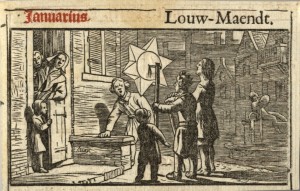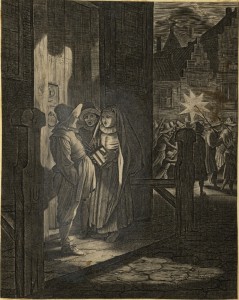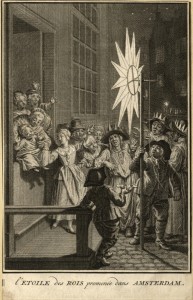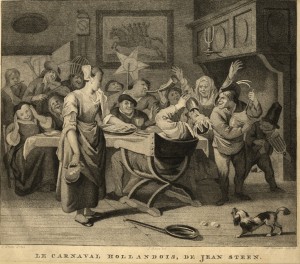A few months ago, I came across the image below while cataloguing a series of prints of the months from a late seventeenth-century almanac in Douce’s collection:

Christoffel van Sichem IV and Jan de Bray, Januarius / Louw-Maendt, c. 1694, woodcut (Ashmolean Museum, Oxford)
The man pouring water from a vase next to a fountain in the background of this nocturnal scene alludes to the Zodiac sign of Aquarius. The foreground, however, is occupied by a group of children that go from house to house carrying a lantern in the shape of a star. They celebrate the feast of Twelfth Night which, according to Anke A. van Wagenberg-ter Hoeven, was ‘the most important family gathering of the year in the seventeenth-century Netherlands’. Two impressions of Jan de Velde II’s The star of the kings, considered as ‘the earliest depiction of star-singers’, were kept by Douce with his prints of popular amusements:

Jan van de Velde II after Pieter de Molijn, The star of the kings, c. 1630, engraving (Ashmolean Museum, Oxford)
Bernard Picart also included the star-singers among his illustrations for the Cérémonies et coutumes religieuses de tous les peuples du monde (1723-1743):

Bernard Picart, L’Etoile des Rois promenée dans Amsterdam, 1726-33, engraving (Ashmolean Museum, Oxford)
Douce cut Picart’s illustration from the book and he filed it with the print by Van de Velde, on the back of which he pasted a piece of paper with the account of the Dutch Twelfth Night provided in the Cérémonies. A compulsive extractor (and annotator), Douce later added another scrap scribbled with a description of a parade involving the three kings and a star that took place in Florence in 1467, found in Machiavelli’s Istorie Fiorentine (1532).
In her study of “The celebration of Twelfth Night in Netherlandish art”, Van Wagenberg-ter Hoeven establishes a distinction between ‘outdoor’ and ‘domestic’ celebrations. Both types are combined in this Carnaval Hollandois after Jan Steen, also from Douce’s collection, which shows the star-singers entering a room where the Twelfth-Night king drinks surrounded by revelers:

